Strength and Durability Characteristics of Cement Composites with Recycled Water and Blast Furnace Slag Aggregate
Abstract
1. Introduction
2. Materials and Methods
2.1. Materials
2.2. Mixing Proportions and Specimen Preparation
3. Results and Discussion
3.1. Mortar Flow
3.2. Compressive Strength
3.3. Split-Tensile Strength
3.4. Drying Shrinkage
3.5. Accelerated Carbonation Depth
3.6. Chloride-Ion Penetrability
4. Conclusions
- (1)
- In this study, using RW did not significantly affect the mortar flow, but the mortar flow increased with the replacement ratio of BSFA, which seems to be due to the vitreous properties of blast furnace slag aggregates;
- (2)
- The 28-day compressive strengths of the control sample and RW5BS0 sample were similar, and the compressive strengths of all the samples using RW and BSFA were higher than that of the control sample. Further, the split-tensile strengths of the samples increased with the BSFA replacement ratio, similar to the tendency of the compressive strength;
- (3)
- It was found that when the replacement ratio of BSFA was lower than 20%, the drying shrinkage of the cement mortar using RW was effectively reduced. In the case of the samples using RW, as the BSFA replacement ratio was increased, the carbonation depth of the samples decreased, and the accelerated carbonation depth of the RW5BS40 sample using RW and 40% of BSFA was the lowest at approximately 0.56 mm;
- (4)
- In the case of the mixtures using RW and BSFA, the charge passed through the sample tended to decrease gradually as the BSFA replacement ratio was increased;
- (5)
- Therefore, when RW and BSFA are used properly, it is expected that the mechanical properties of cement mortar, carbonation resistance, and chloride ion penetration resistance can be enhanced.
Author Contributions
Funding
Institutional Review Board Statement
Informed Consent Statement
Data Availability Statement
Acknowledgments
Conflicts of Interest
References
- Min, T.B. An Experimental Study on the Development of EMP Shielding Concrete According to the Types of Aggregates of Industrial By-products. J. Korean Recycl. Constr. Resour. Inst. 2020, 8, 310–316. [Google Scholar]
- Lee, B.K.; Kim, G.Y.; Koo, K.M.; Shin, K.S. Properties of Compressive Strength of Mortar Based on High-activated Blast Furnace Slag using the Slag by-product as an Activator. J. Korea Inst. Build. Constr. 2014, 14, 37–44. [Google Scholar] [CrossRef]
- Cho, W.J.; Ann, K.Y. A Study on the Hydration Characteristics and Fundamental Properties of Ternary Blended Cement Using Ferronickel Slag and Fly Ash. J. Korea Concr. Inst. 2020, 32, 27–35. [Google Scholar] [CrossRef]
- Siddipue, R. Utilization of Industrial By-products in Concrete. Procedia Eng. 2014, 95, 335–347. [Google Scholar] [CrossRef]
- Kim, G.H.; Kim, K.J.; Lee, M.H.; Lee, S.H.; Han, C.G. Properties of cement mortar with solid content and leaving time of recycling water using stabilizing agent. JAIK 2013, 23, 355–358. [Google Scholar]
- Sandrolini, F.; Franzoni, E. Waste wash water recycling in ready-mixed concrete plants. Cem. Concr. Res. 2001, 31, 485–489. [Google Scholar] [CrossRef]
- Yang, E.I.; Park, J.H.; Kim, K.L.; Cho, G.J. Durability and Strength Characteristics of Concrete Using Sludge Water above Specification. J. Korea Concr. Inst. 2006, 18, 199–204. [Google Scholar] [CrossRef]
- Ekolu, S.O.; Dawneerangen, A. Evaluation of recycled water recovered from a ready-mix concrete plant for reuse in concrete. J. S. Afr. Inst. Civ. Eng. 2010, 52, 77–82. [Google Scholar]
- Oh, T.G.; Kim, J.H.; Bae, S.H.; Choi, S.J. A Study on the Strength, Drying Shrinkage and Carbonation Properties of Lightweight Aggregate Mortar with Recycling Water. J. Korea Inst. Build. Constr. 2020, 20, 391–397. [Google Scholar]
- Lee, S.H.; Jung, Y.W.; Yeo, I.D.; Choi, J.O.; Bae, S.H. Physical Properties of Shale Aggregate and Characteristics of Concrete in Replacement Ratio in Daegu-Kyeongbuk Region. J. Korea Acad. Ind. Coop. Soc. 2020, 13, 5551–5557. [Google Scholar]
- Park, K.T.; Han, M.C.; Hyun, S.Y. Analysis the Use of Concrete Fine Aggregates of Coal Gasification Slag. J. Korean Recycl. Constr. Resour. Inst. 2019, 7, 101–108. [Google Scholar]
- Yüksel, İ.; Bilir, T.; Özkan, Ö. Durability of concrete incorporating non-ground blast furnace slag and bottom ash as fine aggregate. Build. Environ. 2007, 42, 2651–2659. [Google Scholar] [CrossRef]
- Valcuende, M.; Benito, F.; Parra, C.; Miñano, I. Shrinkage of self-compacting concrete made with blast furnace slag as fine aggregate. Constr. Build. Mater. 2015, 76, 1–9. [Google Scholar] [CrossRef]
- Hiraskar, K.G.; Patil, C. Use of Blast Furnace Slag Aggregate in Concrete. Int. J. Appl. Eng. Res. 2013, 4, 95–98. [Google Scholar]
- Nataraja, M.C.; Dileep Kumar, P.G.; Manu, A.S.; Sanjay, M.C. Use of granulated blast furnace slag as fine aggregate in cement mortar. Int. J. Struct. Civ. Eng. Res. 2013, 2, 59–68. [Google Scholar]
- Ryou, J.S.; Song, H.H.; Kim, S.S.; Lee, J.B. New technology of blastfurnace slag activation with recycling water from ready-mixed concrete production. Cem. Wapno Beton 2013, 18, 33–38. [Google Scholar]
- Oh, T.G.; Bae, S.H.; Lee, D.G.; Choi, S.J. The Fluidity and Compressive Strength Properties of Lightweight Mortar Using Recycling Water for Pre-wetting of Artificial Lightweight Aggregate. J. Korea Inst. Build. Constr. 2019, 19, 153–154. [Google Scholar]
- KS L 5105. Testing Method for Compressive Strength of Hydraulic Cement Mortars; Korea Industrial Standards; Korean Standards & Certification Information Center: Seoul, Korea, 2007; 5p.
- KS F 2423. Standards Test Method for Tensile Splitting Strength of Concrete; Korea Industrial Standards; Korean Standards & F 2423; Standards & Certification Information Center: Seoul, Korea, 2016; 12p.
- KS F 2424. Standard Test Method for Length Change of Mortar and Concrete; Korea Industrial Standards; Korean Standards & Certification Information Center: Seoul, Korea, 2015.
- KS F 2584. Standard Test Method for Accelerated Carbonation of Concrete; Korea Industrial Standards; Korean Standards & Certification Information Center: Seoul, Korea, 2015.
- ASTM C 1202. Standard Test Method for Electrical Indication of Concrete’s Ability to Resist Chloride Ion Penetration; American Society for Testing and Materials: West Conshohocken, PA, USA, 2019. [Google Scholar]
- Fang, S.; Lam, E.S.S.; Li, B.; Wu, B. Effect of alkali contents, moduli and curing time on engineering properties of alkali activated slag. Constr. Build. Mater. 2020, 249, 1–9. [Google Scholar] [CrossRef]
- Mohamed, O.A. A review of durability and strength characteristics of alkali-activated slag concrete. Materials 2019, 2019, 1198. [Google Scholar] [CrossRef] [PubMed]
- Puertas, F.; Palacios, M.; Gil-Maroto, A.; Vazquez, T. Alkali-aggregate behavior of alkali-activated slag mortars: Effect of aggregate type. Cem. Concr. Compos. 2009, 31, 277–284. [Google Scholar] [CrossRef]

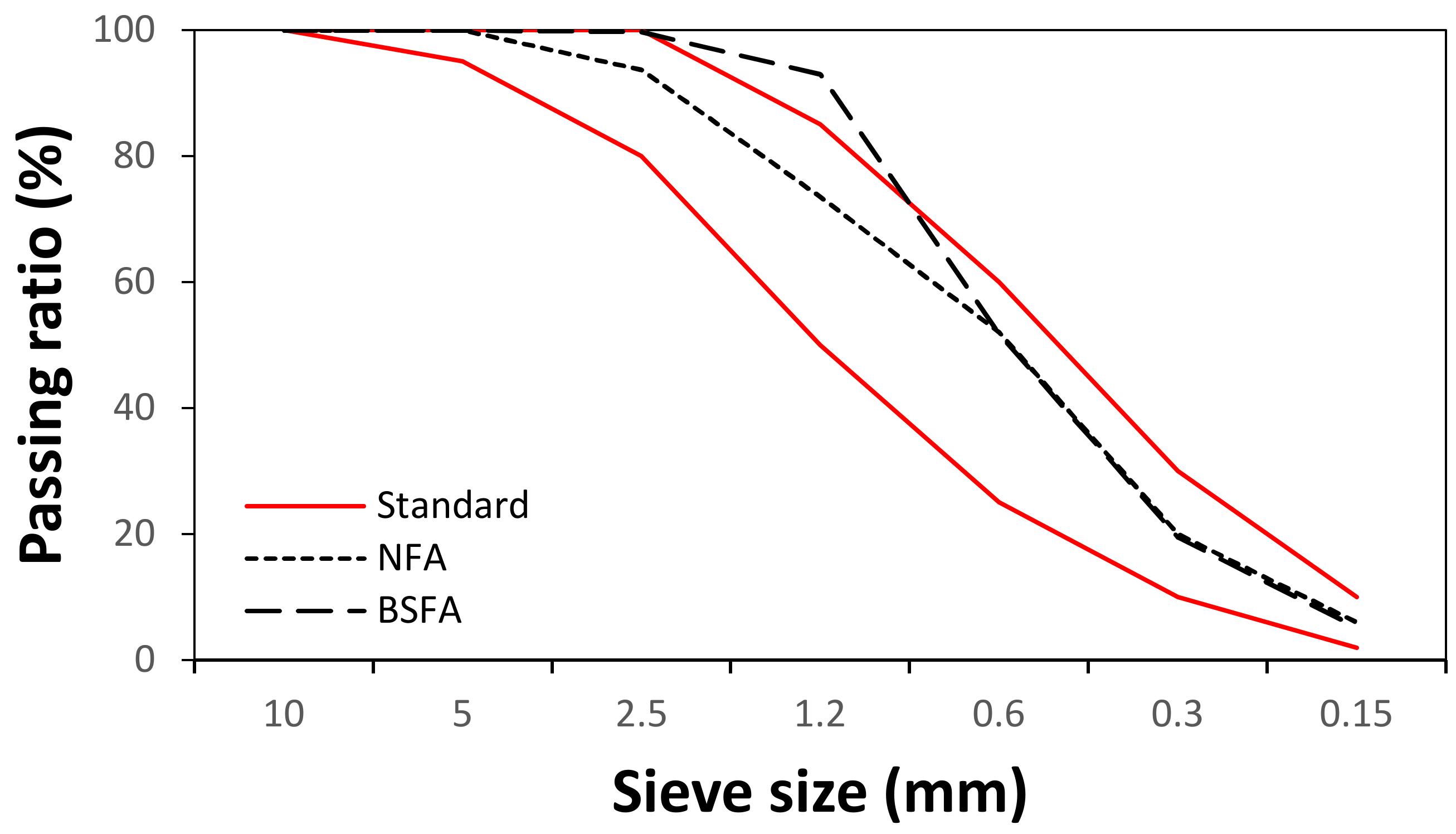
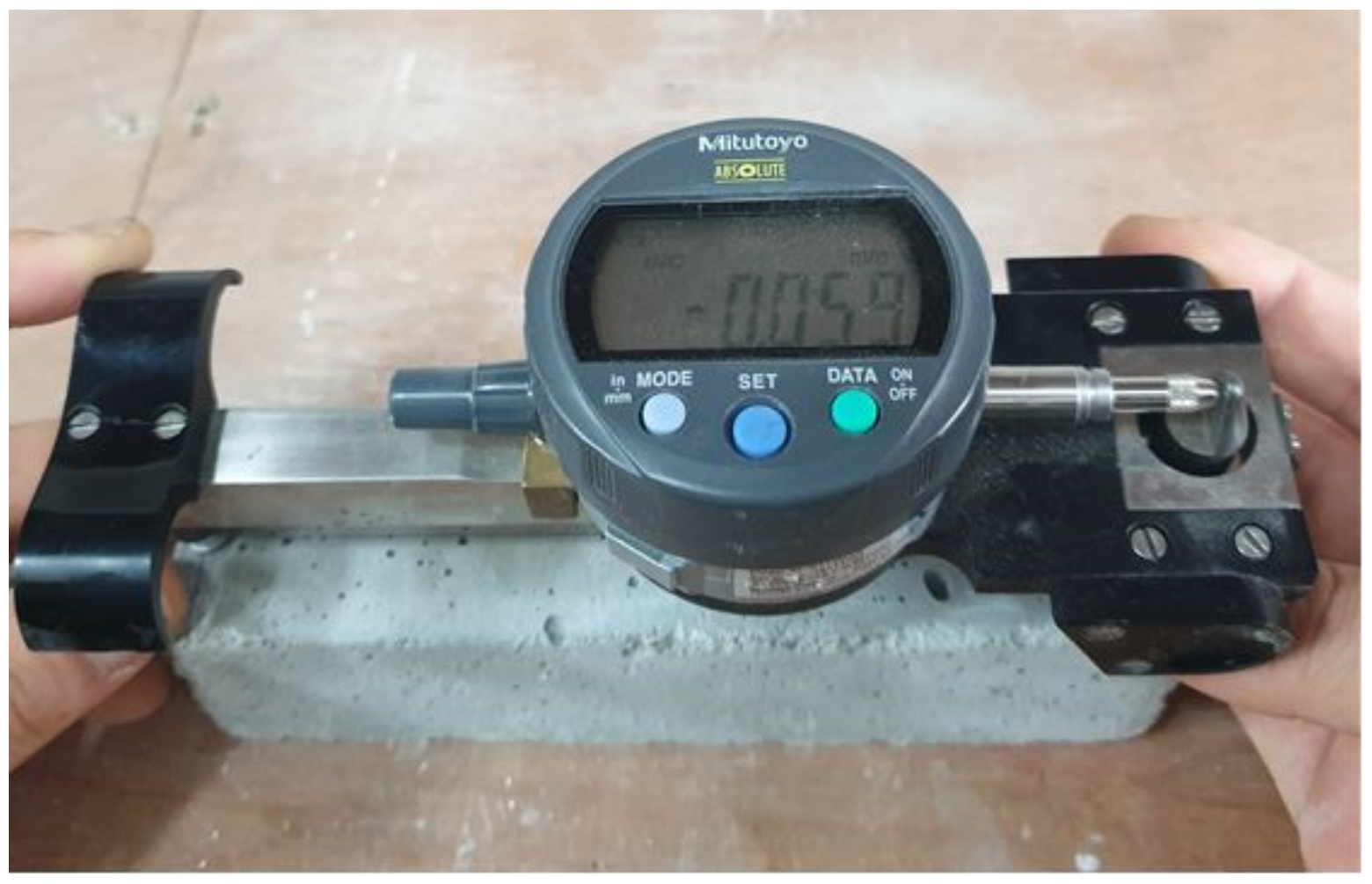
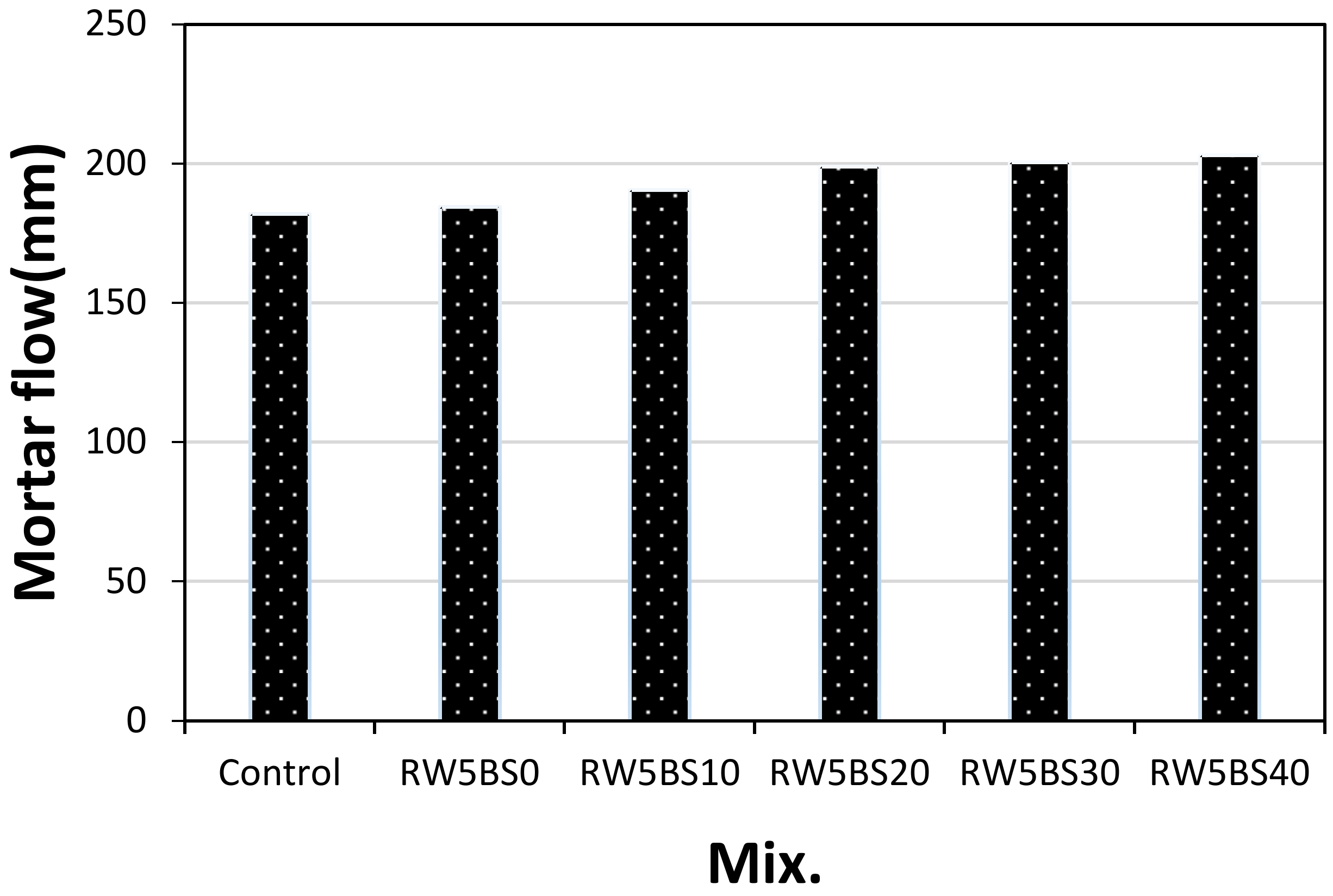


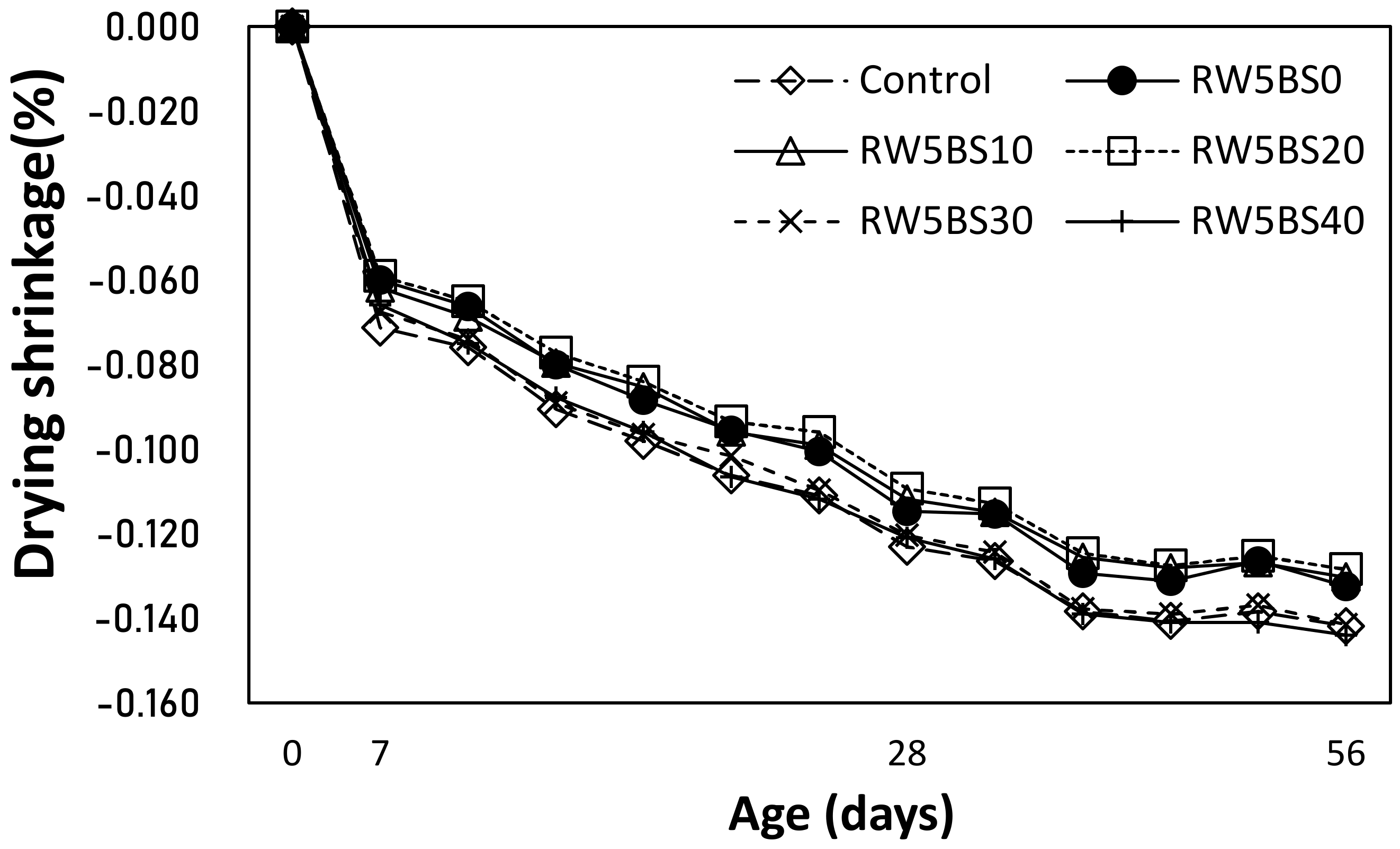
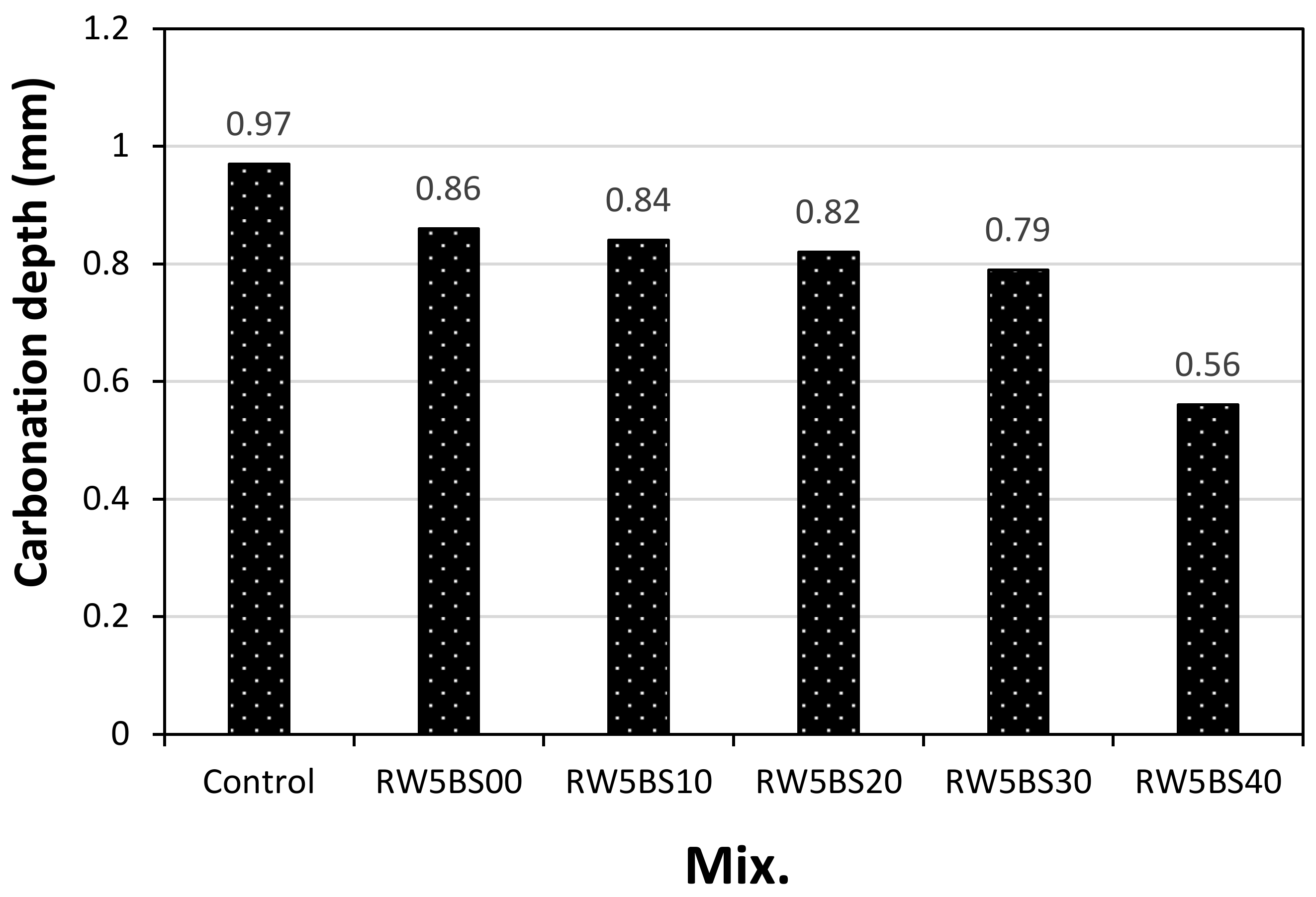
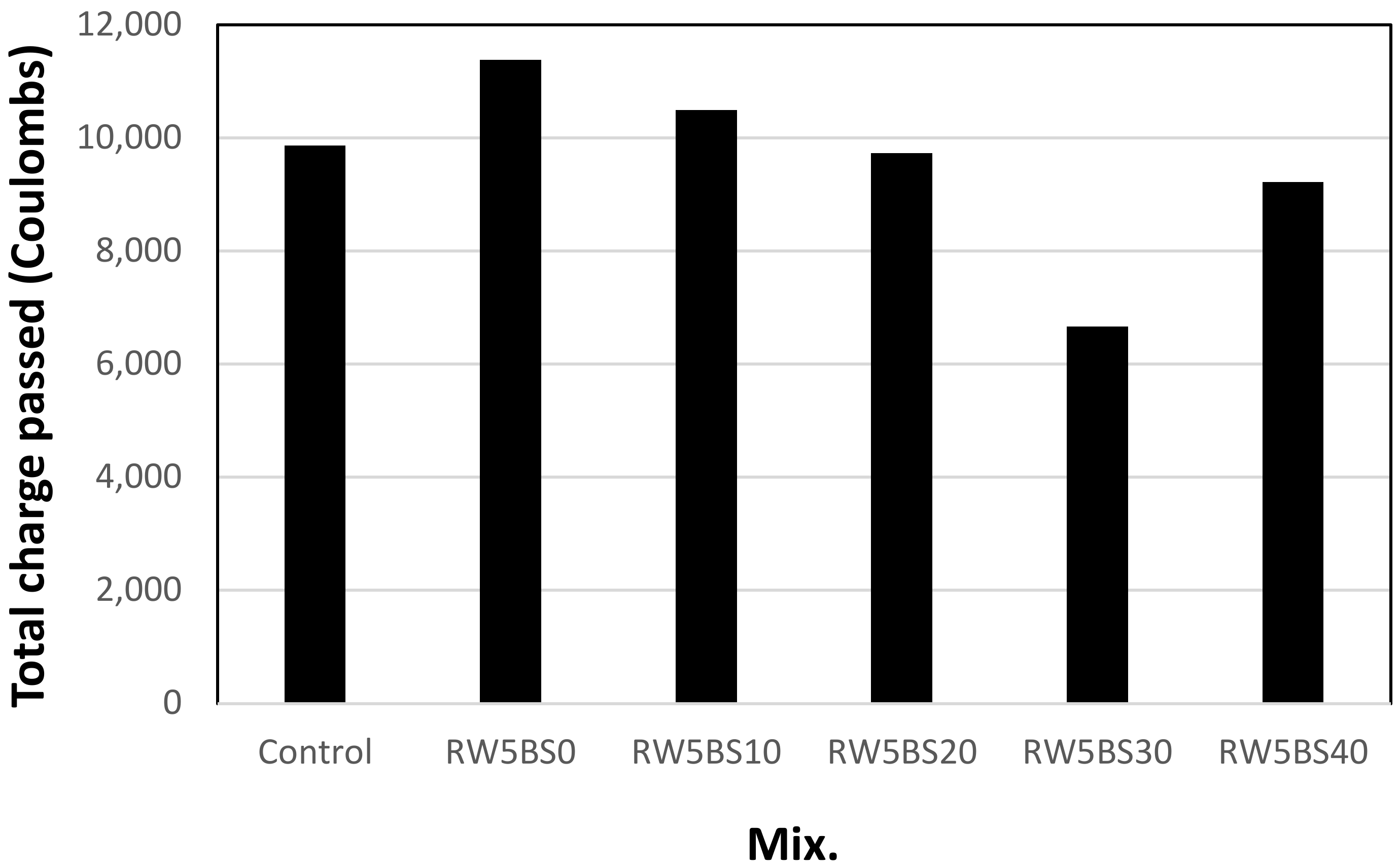
| Mix | W/C (%) | Water (g) | Cement (g) | Sand Fines (g) |
|---|---|---|---|---|
| Sludge | 50 | 200 | 400 | 100 |
| Type | SiO2 | Al2O3 | Fe2O3 | CaO | MgO | K2O |
|---|---|---|---|---|---|---|
| OPC | 17.43 | 6.50 | 3.57 | 64.40 | 2.55 | 1.17 |
| Type | Fineness Modulus (FM) | Density | Water Absorption Ratio (%) |
|---|---|---|---|
| Natural fine aggregate (NFA) | 2.45 | 2.60 | 1.0 |
| Blast furnace slag fine aggregate (BSFA) | 2.30 | 2.80 | 2.1 |
| BSFA (%) | Sludge Content (%) | W/C (%) | Water (kg/m3) | Cement (kg/m3) | NFA (kg/m3) | BSFA (kg/m3) | |
|---|---|---|---|---|---|---|---|
| Control | 0 | 0 | 50 170 340 | 739 | 0 | ||
| RW5BS0 | 0 | 5 | 739 | 0 | |||
| RW5BS10 | 10 | 5 | 665 | 80 | |||
| RW5BS20 | 20 | 5 | 591 | 160 | |||
| RW5BS30 | 30 | 5 | 518 | 240 | |||
| RW5BS40 | 40 | 5 | 444 | 320 | |||
Publisher’s Note: MDPI stays neutral with regard to jurisdictional claims in published maps and institutional affiliations. |
© 2021 by the authors. Licensee MDPI, Basel, Switzerland. This article is an open access article distributed under the terms and conditions of the Creative Commons Attribution (CC BY) license (https://creativecommons.org/licenses/by/4.0/).
Share and Cite
Choi, S.-J.; Bae, S.-H.; Lee, J.-I.; Kim, J.-H. Strength and Durability Characteristics of Cement Composites with Recycled Water and Blast Furnace Slag Aggregate. Materials 2021, 14, 2156. https://doi.org/10.3390/ma14092156
Choi S-J, Bae S-H, Lee J-I, Kim J-H. Strength and Durability Characteristics of Cement Composites with Recycled Water and Blast Furnace Slag Aggregate. Materials. 2021; 14(9):2156. https://doi.org/10.3390/ma14092156
Chicago/Turabian StyleChoi, Se-Jin, Sung-Ho Bae, Jae-In Lee, and Ji-Hwan Kim. 2021. "Strength and Durability Characteristics of Cement Composites with Recycled Water and Blast Furnace Slag Aggregate" Materials 14, no. 9: 2156. https://doi.org/10.3390/ma14092156
APA StyleChoi, S.-J., Bae, S.-H., Lee, J.-I., & Kim, J.-H. (2021). Strength and Durability Characteristics of Cement Composites with Recycled Water and Blast Furnace Slag Aggregate. Materials, 14(9), 2156. https://doi.org/10.3390/ma14092156







